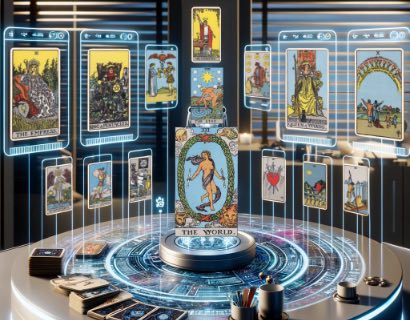The Wheel of Fortune Tarot Card Meaning & Interpretations
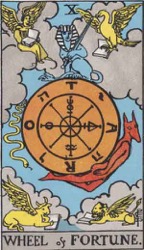
The number 10 marks the beginning of a new cycle after the completion of an old one. In numerology 10 reduces to 1 (1+0=1) which connects it to Tarot's Aces and The Magician. What makes it different is that it begins on top of a preceding cycle whereas the cards numbered 1 symbolise a fresh start with no history or carry over. Therefore The Wheel of Fortune marks a new beginning for something that is already part of your life. Compare The Wheel of Fortune to the 10s of the Minor Arcana which symbolise a new cycle beginning on the foundations of one, or many, previous cycles of their element. In the 10 Of Pentacles this is collective wealth, accumulated over generations of gathering material possessions, beginning a new cycle. Natural cycles are always different. No two years are ever the same. This is why this card is named Wheel of Fortune because the wheel is cyclic and each cycle, each rotation of it, will bring different fortunes, luck, challenges, defeats and success.
The Rider Waite Smith (RWS) deck uses a mixture of Egyptian, Graeco-Roman and Christian symbolism in its depiction of The Wheel of Fortune. In each of the four corners of the card are the "four living creatures" Ezekiel describes in the old testament (Ezekiel 1:1-10) . They are also described in John's vision in Revelation (4:6–8) as sitting around the throne in heaven. Smith and Waite included the same four characters in the corners of The World card of their RWS deck. In The World they symbolise reaching heaven, ascension or enlightenment. In the The Wheel of Fortune they symbolise the notion that one's fate is dictated by Divine Providence. The Wheel is inscribed with two words, their letters inter-changing. "TARO" and the Hebrew "יהוה" (or YHWH in Latin) which Waite states is the "Divine Name" ie the name of God. The world "TARO" can also be read as "ROTA" from the Latin for "wheel". The Sphinx sitting on top of the wheel is a guardian of sorts to balance the inclusion of the serpent on the left and Typhon below the wheel. Typhon is Greek mythology's equivalent to the Christian Devil. A monstrous deity who tried to over throw Zeus and failed only to be cast down and buried under a volcano. The inclusion of these characters is probably to symbolise the unpredictable and chaotic influences that make each cycle of the wheel different.
The Wheel of Fortune symbolises a feeling of something being different about familiar routines or habits. Like beginning a new year at school you are in the same place but a year ahead, studying more advanced subjects with different teachers and timetables. Your failures or successes from the previous year will no doubt play a part in how this year begins. Fate and destiny will also play a part of how this new cycle starts and unfolds. You have to prove yourself once more and there is no guarantee that this cycle will be a repeat of the last one as your fortunes can rise or fall. A simple interpretation of this card can be gambling, or taking a chance.
© Phuture Me Ltd 2010-2019. All rights reserved.
THE PICTORIAL KEY TO THE TAROT
By Arthur Edward Waite (1911)
In this symbol I have again followed the reconstruction of Éliphas Lévi, who has furnished several variants. It is legitimate--as I have intimated--to use Egyptian symbolism when this serves our purpose, provided that no theory of origin is implied therein. I have, however, presented Typhon in his serpent form. The symbolism is, of course, not exclusively Egyptian, as the four Living Creatures of Ezekiel occupy the angles of the card, and the wheel itself follows other indications of Lévi in respect of Ezekiel's vision, as illustrative of the particular Tarot Key. With the French occultist, and in the design itself, the symbolic picture stands for the perpetual motion of a fluidic universe and for the flux of human life. The Sphinx is the equilibrium therein. The transliteration of Taro as Rota is inscribed on the wheel, counterchanged with the letters of the Divine Name--to shew that Providence is imphed through all. But this is the Divine intention within, and the similar intention without is exemplified by the four Living Creatures. Sometimes the sphinx is represented couchant on a pedestal above, which defrauds the symbolism by stultifying the essential idea of stability amidst movement.
Behind the general notion expressed in the symbol there lies the denial of chance and the fatality which is implied therein. It may be added that, from the days of Lévi onward, the occult explanations of this card are--even for occultism itself--of a singularly fatuous kind. It has been said to mean principle, fecundity, virile honour, ruling authority, etc. The findings of common fortune-telling are better than this on their own plane.
Related Tarot Cards
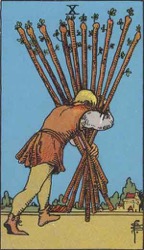 |
 |
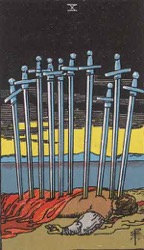 |
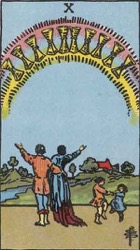 |
 |
© Phuture Me Ltd 2019. All rights reserved.
